![]()
![]()
![]()
Use LEFT and RIGHT arrow keys to navigate between flashcards;
Use UP and DOWN arrow keys to flip the card;
H to show hint;
A reads text to speech;
58 Cards in this Set
- Front
- Back
|
how do you differentiate autolysis and necrosis
|
autolysis
- lacks host response - is diffuse |
|
|
how is the rate of autolysis affected by tissue type
|
Rapid (in areas w/a lot of enzymes)
• gall bladder and near gall bladder • pancreas • intestines intermediate rate • liver • kidney • spleen slow • bones • cartilage • skin adjacent tissue effect: if intestines autolyze quickly, things close to intestines will also autolyze quickly |
|
|
what tissues have fast autolysis rate
|
in areas w/a lot of enzymes
• gall bladder and near gall bladder • pancreas • intestines |
|
|
what tissues have intermediate autolysis rate
|
kidney
liver spleen |
|
|
what tissues have show autolysis rate
|
bone
cartilage skin |
|
|
what factors contribute to autolysis
|
Tissue type
Temperature: higher temp, faster autolysis • Climate temperature • Higher body temperatures bacT: why intestines autolyze so quickly • bacteremia insulation: sheep w/heavy wool, fat animals |
|
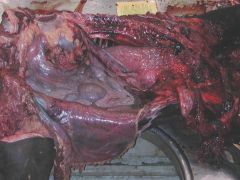
|
adjacent tissue effect on autolysis
|
|
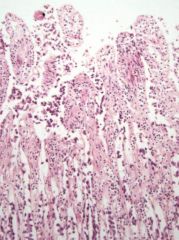
|
rapid autolysis
|
|
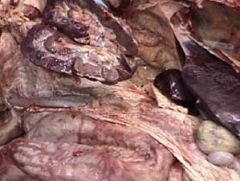
|
intermediate autolysis rate
|
|
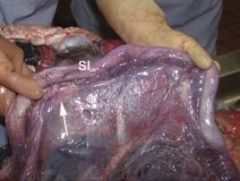
|
rapid autolysis rate
|
|
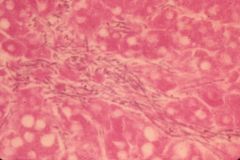
|
bacteria increases autolysis rate
|
|
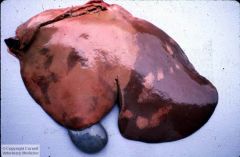
|
bact increases autolysis rate
|
|
|
common postmortem lesions
gas accumulation |
• Bloat
o post-mortem o Bloat line: vessels feeding esophagus are compressed, all tissues cranial to thoracic inlet are congested, means that blood was still pumping when bloat happened (ante-mortem) o antemortem - subQ isn’t gas filled o rectal prolapse - from gas production pushing it out • emphysema o gas bubble holes in many tissues, SQ, and visceral organs (play-doh) o way to big to be lipids |
|
|
common postmortem lesions
gastric rupture |
occurs postmortem (esp in rabbits and horses)
if antemortem, there will be hemorrhage around it |
|
|
common postmortem lesions
discoloration |
bile imbibition (green or green yellow staining around gall bladder)
- esp in starving animals - easiest to see in fat Hgb imbibition - due to postmortem hemolysis - stains tissue red - due to euth soln - indistinct margins pseudomelanosis - looks like melanin (black) or green - anywhere in abd - due to bacteria acting on RBC - prominent in lymphoid tissue - never see in aborted fetus b/c not bact in intestine |
|
|
what causes algor mortis
|
drop in body temp after death
depends on environ temp and insulation |
|
|
common postmortem lesions
liver mortis |
pooling of blood on down side
purple discoloration seen in pigs and humans |
|
|
common postmortem lesions
rigor mortis |
due to depletion of ATP and glycogen (needed for musc relaxation)
transient - starts at 2-4 hrs - ends at 24-48 hrs |
|

|
bloat line
only in antemortem vessels feeding esophagus are compressed, all tissues cranial to thoracic inlet are congested, means that blood was still pumping when bloat happened |
|
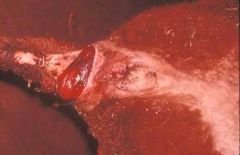
|
common postmortem lesions
bloat associated rectal prolapse |
|
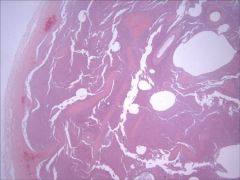
|
common postmortem lesions
gas accumulation - emphysema |
|
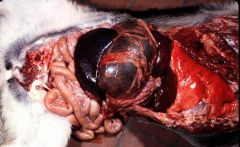
|
antemortem bloat
|
|
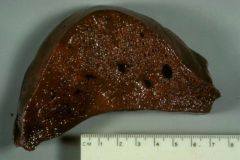
|
common postmortem lesion
gas accumulation - emphysema |
|

|
common postmortem lesions
gas accumulation - emphysema |
|

|
postmortem gastric rupture
|
|
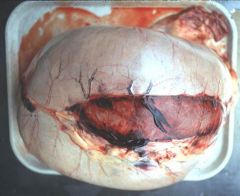
|
antemortem gastric rupture
notice hemorrhage |
|
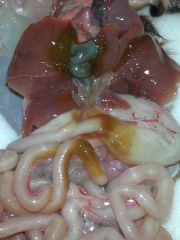
|
bile imbibition
|
|
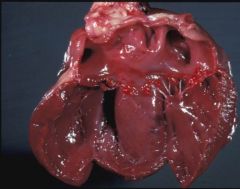
|
Hgb imbibition
|
|
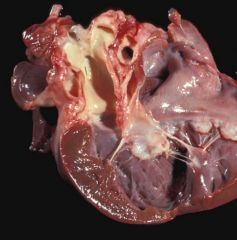
|
Hgb imbibition
due to RBC hemolysis postmortem |
|
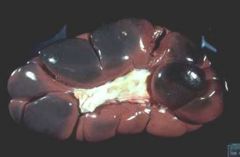
|
Pseudomelanosis
H2S (from bacteria) + Fe (from RBC) => FeS (which is green-black) most common in abd |
|
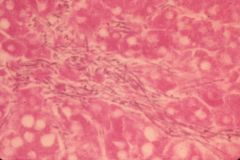
|
Pseudomelanosis
H2S (from bacteria) + Fe (from RBC) => FeS (which is green-black) most common in abd |
|
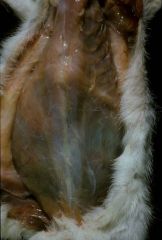
|
Pseudomelanosis
H2S (from bacteria) + Fe (from RBC) => FeS (which is green-black) most common in abd |
|
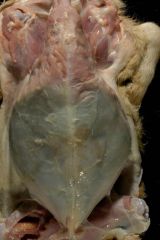
|
Pseudomelanosis
H2S (from bacteria) + Fe (from RBC) => FeS (which is green-black) most common in abd |
|
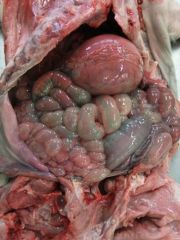
|
Pseudomelanosis
H2S (from bacteria) + Fe (from RBC) => FeS (which is green-black) most common in abd |
|
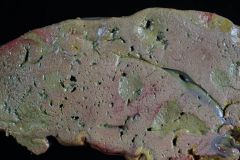
|
autolyzed bovine liver
|
|
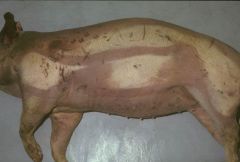
|
livor mortis
|
|
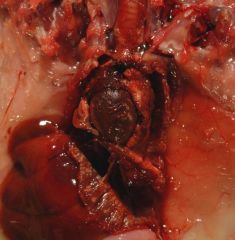
|
euthanasia precipitate
|
|
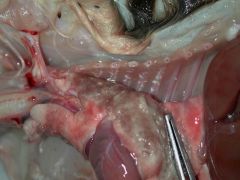
|
euthanasia precipitate
|
|
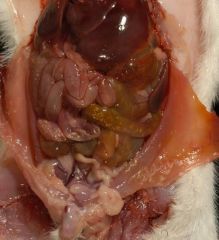
|
euthanasia precipitate
|
|
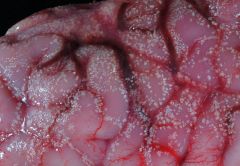
|
euthanasia precipitate
|
|
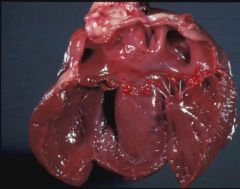
|
hemoglobin imbibition due to euth
|
|
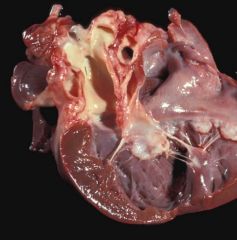
|
hemoglobin imbibition due to euth
|
|
|
how does formalin fixation prevent autolysis
|
kills
- stops putrefaction (kills bact) and autolysis (cross-links enzymes) penetrates - depends on size and density of tissue (1 cm for formalin) hardens - cross-links proteins - stabalizes tissue in its original orientation |
|
|
what are ways to fix tissue
|
formalin
heat dessication (not good for histopath) |
|
|
how can you prevent autolysis
|
fix tissue
- formalin - heat - dessication refrigeration - slows autolysis by slowing bact growth and enzyme rxns freezing - stops autolysis but ruins tissue for histopath |
|
|
what factors affect fixation
|
pH
- acidic formalin forms pigment (acid hematin) volume ratio - 10:1 - tissue binds fixative molecules and depletes them from soln - after a tissue is fixed it can be put in a smaller volume for fixing time - bx should be placed in formalin immediately - necropsies should be done asap - allow 24 hrs to fix tissue |
|
|
what other factors affect histopathology (other than fixation/ preventing autolysis)
|
friction
- on mucosal surfaces compression electric current prior sectioning of surgical margins - don't cut through surgical margin - do ink the surgical margin |
|
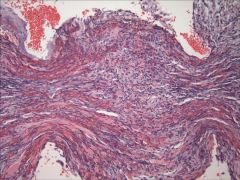
|
compression = bad juju
|
|
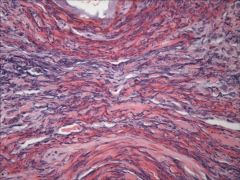
|
compression = angry pathologist
|
|

|
friction = unhappy mucous membranes
|
|
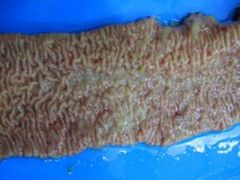
|
friction = a pathologic waste of money
|
|

|
freeze artifact = pathologist chasing after you with a container of parafin to fix you in and then slice you into little pieces and mount them on a slide
|
|
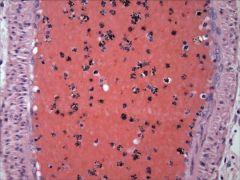
|
pH of formalin too acidic
acid hematin |
|
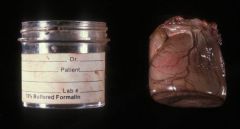
|
mmm steak
|
|
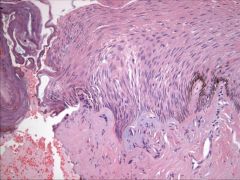
|
a pomeranian with a bad hair day....
j/k. electrocautery artifact |
|
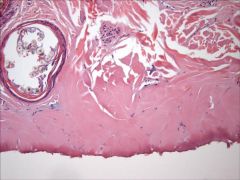
|
a well seared steak
electrocautery artifact |
|
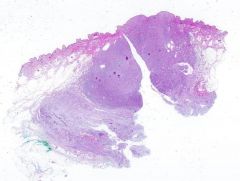
|
bad sectioning
|
|
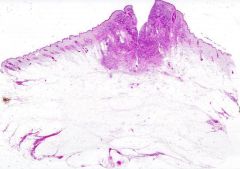
|
good sectioning
|

